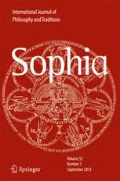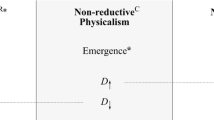Abstract
In this article, I offer a critical evaluation of non-reductive physicalism as articulated and defended by Nancey Murphy. I argue that (A) the examples given by Murphy do not illustrate robust emergence and the philosophical idea of downward causation. (B) The thesis of multiple realizability is ontologically neutral, and so cannot support the idea of the causal efficacy of higher-level properties. (C) Supervenience is incompatible with strong emergence. I also argue for the fruitful relationship between emergence theory and panpsychism pertaining to the metaphysical issue of the origin and nature of mind.
Similar content being viewed by others
Notes
A naturalist who seems to hold to an epistemological conception of emergence is Colin McGinn who argues for ‘agnostic naturalism’ (see McGinn 1993).
A similar distinction is made by Timothy O’Connor and Hon Yu Wong. They distinguish between structural properties and non-structural properties. A structural property S is defined by the relation of the parts of S. A non-structural property, on the other hand, does not even partly consist in the instantiation of distinct properties by the entities or its parts. O’Connor and Wong maintain that robust ontological emergence is dependent on a view of properties as being non-structural. See O’Connor and Wong (2005).
Peacocke writes ‘For to be real is to have causal powers’, (Peacocke 2006: 262). Clayton argues in the following way about the importance of causal efficacy: ‘one cannot make sense of mental causation except from the standpoint of strong emergence. If the strong emergence interpretation of mental causes is not correct, one should be an epiphenomenalist about mind, that is, one should hold that mind has no effect on the world’, (Clayton 2004:108). Similar to Clayton, Mark A. Bedau writes that ‘Emergence is interesting in part because of emergent causal powers. Emergent phenomena without causal powers would be mere epiphenomena’, (Bedau 2008: 175).
By ‘sufficient’ Murphy probably means that the physical base structure is enough to explain M such that there is no need to invoke a non-physical category to explain M.
Murphy’s idea regarding the notion of mind being constituted by its environment is related to ‘the extended mind’thesis. See, in particular, Andy Clark’s and David Chalmers’ seminal paper on extended mind, (Clark and Chalmers 1998).
For an interesting linguistic treatment of naturalism, see Price (2011).
See Post (1987: 159–208).
Moreland, in (2008: 114–134), critiques David Skrbina’s form of panpsychism for being philosophically inadequate, and suggests that his own dualism is superior to a panpsychist conception of the consciousness.
Strawson received some significant critique for his definition of physicalism.
What Strawson opts for instead is a form of monism, or a ‘dual-aspect view’, whereby experiential and non-experiential properties ‘exist in such a way that neither can be said to be based in or realized by or in any way asymmetrically dependent on the other…’ (Strawson 2006b: 241–246).
For Murphy, goal-directedness is not confined to higher-level organisms. Indeed, ‘even at the level of single-celled organisms we find a degree of self-direction’ (Murphy 2006: 86).
For an explanation of resultant properties, see Kim (2010: 8–49).
Other emergence theorists seem to hold to a view of emergent properties as basic. Timothy O’Connor, for example, writes that ‘The basic properties and relations of our world will be those properties whose instantiation does not even partly consists in the instantiation of distinct properties by the entity or its parts. It is the thesis of emergentism that some basic properties are had by composite individuals’, (O’Connor and Wong 2005: 665). Philip Clayton and Stuart Kauffman have suggested that agency is present even on the molecular level. However, they do not mean that we have full-blown consciousness on the molecular level, only that molecular agents meet five minimal physical conditions (reproduction, work cycles, boundaries for reproducing individuals, self-propagating work, and constrain construction) and choice and action that have evolved to respond to food or poison, which would justify the use of agential language in biological discourses. Hence, ontological emergence is implied by the presence of agency at the molecular level (see Kauffman and Clayton 2006: 501–521). This way of arguing for agency in the natural order bears some resemblance to the panpsychist D.S. Clarke who argues that mentality can ‘be attributed to all natural forms having an appropriate level of unified structural organization that maintains themselves over a period of time against their environments’ (see Clarke 2003: 12). This idea of enduring individuals or subjects possessing minds is also evident in the writings of panexperientialist David Ray Griffin (see Griffin 2000: 137–178; Griffin 2001: 94–128).
My proposal comes close to but should not be equated with Griffin’s panexperientialism. Griffin’s formulation of panexperientialism is helpful for outlining the fundamentality of the mental. I am largely sympathetic to Griffin’s approach. Yet, I am reluctant to label my own approach ‘panexperientialism’ as I think that Griffin’s approach is too focused on experience. I suggest that the subjective dimension that Griffin seeks to retain and protect from reductionism, might include a variety of phenomenal properties, or aspects of qualia (subjective experiences).
References
Bedau, M. (2008). Downward causation and autonomy in weak emergence. In M. Bedau & P. Humprey (Eds.), Emergence: contemporary readings in philosophy and science (pp. 155–188). London: MIT Press.
Chalmers, D. (1996). The conscious mind: in search of a fundamental theory. New York: Oxford University Press.
Clark, A., & Chalmers, D. (1998). The extended mind. Analysis, 58, 7–19.
Clarke, D. S. (2003). Panpsychism and the religious attitude. New York: State University of New York Press.
Clayton, P. (2004). Mind and emergence: from quantum to consciousness. Oxford: Oxford University Press.
Goff, P. (2009). Why panpsychism doesn’t help us explain consciousness. Dialectia, 63, 289–311.
Griffin, D. R. (1998). Unsnarling the world-Knot: consciousness, freedom, and the mind-body problem. Eugene: Wipf and Stock Publishers.
Griffin, D. R. (2000). Religion and scientific naturalism: overcoming the conflicts. Albany: State University of New York Press.
Griffin, D. R. (2001). Reenchantment without supernaturalism: a process philosophy of religion. New York: Cornell University Press.
Kauffman, S. (2008). Reinventing the sacred: a new view of science, reason, and religion. New York: Basic Books.
Kauffman, S., & Clayton, P. (2006). On emergence, agency, and organization. Biology and Philosophy, 21, 501–521.
Kim, J. (2010). Making sense of emergence. In J. Kim (Ed.), Essays in the metaphysics of mind (pp. 8–41). Oxford: Oxford University Press.
McGinn, C. (1993). Problems in philosophy—the limits of inquiry. Oxford: Blackwell Publishers.
McGinn, C. (2006). Hard questions: comments on galen strawson. Journal of Consciousness Studies, 13, 90–99.
Moreland, J. P. (2008). Consciousness and the existence of god: a theistic argument. New York: Routledge.
Moreland, J. P. (2009). The recalcitrant imago dei: human persons and the failure of naturalism. London: SCM Press.
Murphy, N. (1998). Nonreductive physicalism: philosophical issues. In W. S. Brown, N. Murphy & H. N. Malony (Eds.),Whatever happened to the Soul? Scientific and theological portraits of human nature (pp. 127–148). Minneapolis: Fortress Press.
Murphy, N. (2006). Bodies and souls, or spirited bodies? Cambridge: Cambridge University Press.
Murphy, N., & Brown, W. (2007). Did my neurons make me do it? Philosophical and neurobiological perspectives on moral responsibility and free will. New York: Oxford University Press.
Nagel, T. (2012). Mind and cosmos: Why the materialist neo-darwinian conception of nature is almost certainly false. New York: Oxford University Press.
O’Connor, T., & Wong, Y. (2005). The metaphysics of emergence. Noûs, 39, 658–678.
Peacocke, A. (2004). Creation and the world of science: the re-shaping of belief. Oxford: Oxford University Press.
Peacocke, A. (2006). Emergence, Mind, and Divine Action: The Hierarchy of the Sciences in Relation to the Human Mind-Brain-Body. In P. Clayton & A. Peacocke (Eds.), The Re-Emergence of Emergence: The Emergentist Hypothesis from Science to Religion (pp. 257–278). Oxford: Oxford University Press.
Post, J. (1987). The faces of existence: an essay in nonreductive metaphysics. New York: Cornell University Press.
Price, H. (2011). Naturalism without mirrors. New York: Oxford University Press.
Rosenberg, G. (2004). A place for consciousness: Probing the deep structure of the natural world. New York: Oxford University Press.
Seager, W. (1995). Consciousness, information, and panpsychism. Journal of Consciousness Studies, 2, 272–288.
Searle, J. (1997). Consciousness and the philosophers’, review of The Conscious Mind: In Search of a Fundamental Theory, by David J. Chalmers. The New York Review of Books, March Issue.
Skrbina, D. (2005). Panpsychism in the West. Massachusetts: MIT Press.
Skrbina, D. (2006). Realistic panpsychism: commentary on strawson. Journal of Consciousness Studies, 13, 151–157.
Strawson, G. (2006a). Realistic monism: why physicalism entails panpsychism. Journal of Consciousness Studies, 13, 3–31.
Strawson, G. (2006b). Panpsychism? Reply to commentators with a celebration of descartes. Journal of Consciousness Studies, 13, 184–280.
Author information
Authors and Affiliations
Corresponding author
Rights and permissions
About this article
Cite this article
Leidenhag, M. From Emergence Theory to Panpsychism—A Philosophical Evaluation of Nancey Murphy’s Non-reductive Physicalism. SOPHIA 55, 381–394 (2016). https://doi.org/10.1007/s11841-016-0550-0
Published:
Issue Date:
DOI: https://doi.org/10.1007/s11841-016-0550-0




